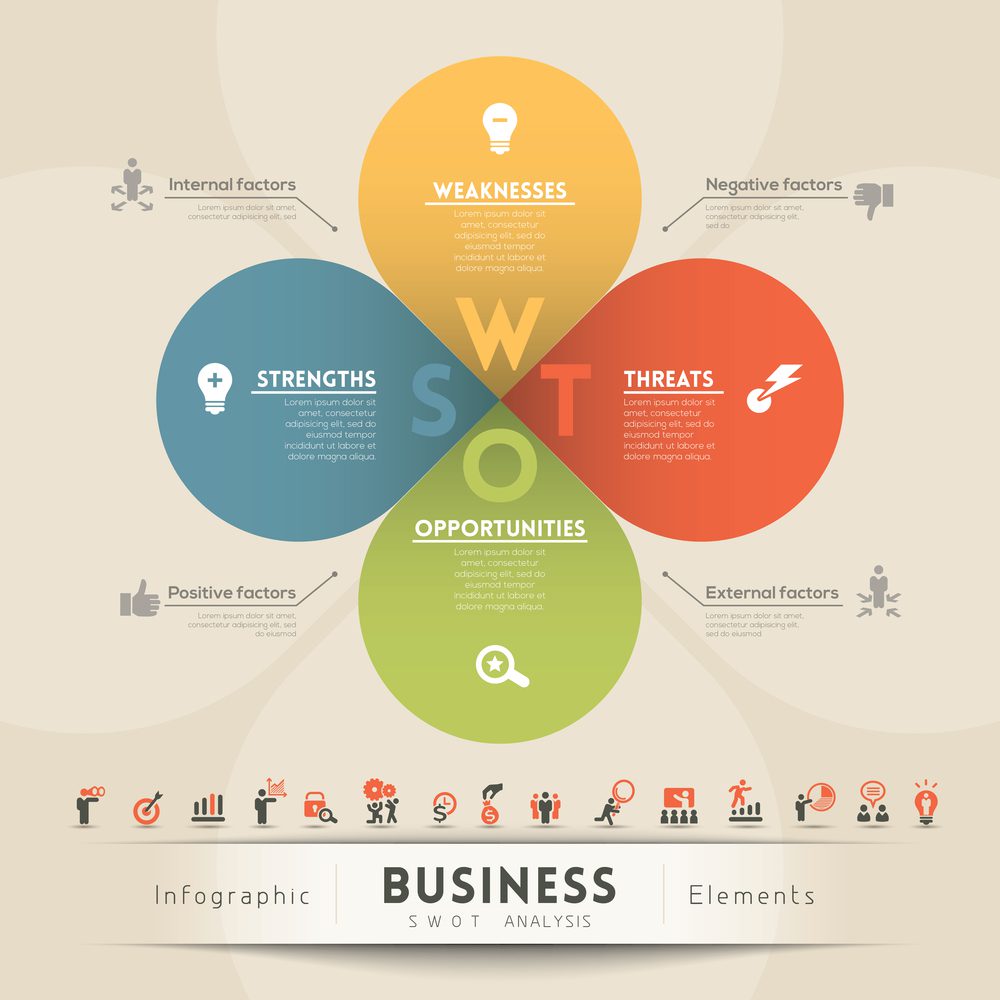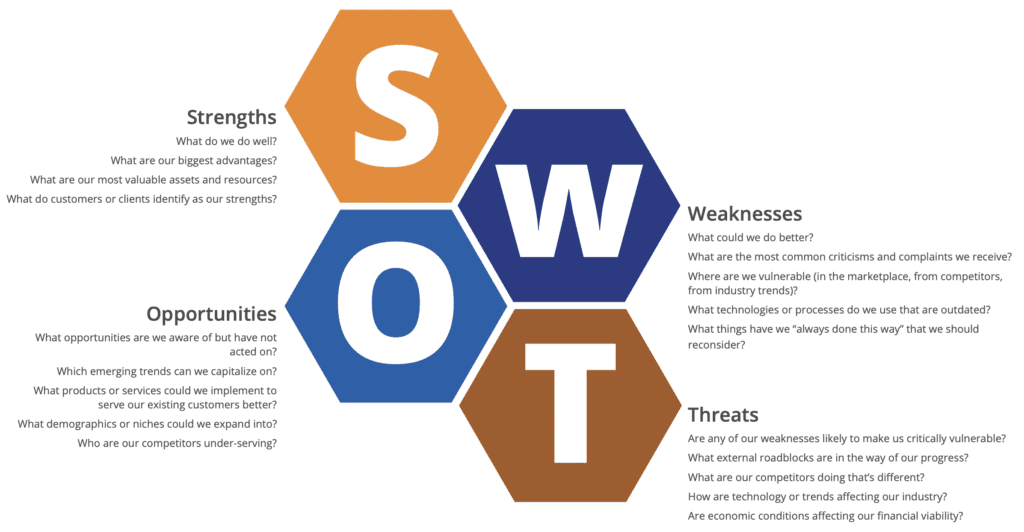Figuring out what the future holds for your business can be hard. Many business owners end up making things up as they go along instead of defining a clear path forward. Instead, outlining a strategic plan forward can help guide businesses in a positive direction, in just four simple steps.
First, understanding the vision, mission, and values of your business is imperative for the foundation of a successful strategic plan. Knowing where your business stands today can help you plan for where will be in the future. You may already have a vision, mission, and core values written, but you should take the time to review them and make sure they still resonate with the vision for the business. Possible changes to circumstances, leadership, or the marketplace may lead to beneficial changes to the vision, mission, and core values. If you don’t already have them, now is the perfect time to take some time to come up with the most meaningful components to the business. Use words and phrases that truly resonate with you and the core of your company.
Second, analyze the business’ strengths, weaknesses, opportunities, and threats (SWOT analysis) to review internal and external factors that contribute to the success or failure of the business. The insight from the SWOT analysis can give you a better understanding of your industry, while cluing into your competitive advantage and recognizing potential threats to growth. In doing the SWOT analysis, ask yourself the questions in the chart below.

DOWNLOAD GUIDE
Third, use the takeaways from your SWOT analysis to create your plan. Define your strategic objectives and set goals. Set 3-5 SMART goals, which should be specific, measurable, achievable, realistic, and time bound. The strategies, or approaches you take to achieve your goals, objectives, and tactic you employ to achieve your goals. Prioritize these goals, asking yourself that if only one thing could happen this year, what would it be?
Finally, it’s time to put your strategic plan into motion. Be transparent about the businesses’ strategic plan and goals with your employees and close professional partners within your organization. This is a great way to increase their engagement, showing them directly how everyday small actions can make a big difference and help them personally in the future as well. Break down your goals into manageable, concrete tasks. Tasks should be broken down as far as you can, asking yourself what you need to know, do, or have in place before an action can be taken. With all of this in mind, build accountability by assigning tasks and setting deadlines.
This process isn’t a one-time thing. Instead of a shiny, final document big companies may use to communicate with investors and shareholders, a strategic plan for small businesses should act as a working document, giving you a clear path forward that adapts with you. Before finishing the planning process, schedule your new few formal reviews (at least once a quarter). This regular review ensures you stay on track and make progress towards your goals. It is important for small and large businesses alike to engage in strategic planning, leaving flexible pathways for the future to take advantage of new opportunities and potential changes.

תיכנון אסטרטגי
שלישית, השתמש בטייקוויטים מניתוח ה- SWOT שלך כדי ליצור את התוכנית שלך. הגדר את היעדים האסטרטגיים שלך והגדר יעדים. הגדר 3-5 מטרות SMART, אשר צריכות להיות ספציפיות, מדידות, ברות השגה, מציאותיות ותחום זמן. האסטרטגיות, או הגישות שאתה נוקט כדי להשיג את המטרות, היעדים והטקטיקה שלך שאתה משתמש כדי להשיג את המטרות שלך. העדיפו עדיפות למטרות אלו, שאלו את עצמכם שאם רק דבר אחד יכול לקרות השנה, מה זה יהיה?
לבסוף, הגיע הזמן להפעיל את התוכנית האסטרטגית שלך. היו שקופים לגבי התוכנית האסטרטגית של העסק ויעדיהם עם עובדיכם ושותפים מקצועיים קרובים בארגון שלכם. זוהי דרך נהדרת להגביר את מעורבותם ולהראות להם באופן ישיר כיצד פעולות קטנות יומיומיות יכולות לחולל שינוי גדול ולעזור להם באופן אישי גם בעתיד. פרקו את יעדיכם למשימות קונקרטיות הניתנות לניהול. יש לפרק את המשימות ככל שתוכל, לשאול את עצמך מה אתה צריך לדעת, לעשות או להיות במקום לפני שניתן לבצע פעולה. עם כל זה בחשבון, בנה אחריות על ידי הקצאת משימות וקביעת מועדים.
להבין מה עתיד העסק שלך יכול להיות קשה. בעלי עסקים רבים בסופו של דבר ממציאים דברים תוך כדי התהליך במקום להגדיר דרך ברורה קדימה. במקום זאת, מתווה תוכנית אסטרטגית קדימה יכול לסייע בהנחיית עסקים בכיוון חיובי, בארבעה צעדים פשוטים בלבד.
ראשית, הבנת החזון, המשימה והערכים של העסק שלך היא הכרחית לבסיס תוכנית אסטרטגית מוצלחת. לדעת איפה העסק שלך עומד היום יכול לעזור לך לתכנן היכן יהיה בעתיד. יתכן שכבר נכתבו חזון, שליחות וערכי ליבה, אך עליכם להקדיש זמן לבדיקתם ולוודא שהם עדיין מהדהדים את החזון של העסק. שינויים אפשריים בנסיבות, במנהיגות או בשוק עשויים להוביל לשינויים מועילים בחזון, במשימה ובערכי הליבה. אם עדיין אין לך אותם, עכשיו זה הזמן המושלם לקחת קצת זמן לבוא עם הרכיבים המשמעותיים ביותר לעסק. השתמש במילים וביטויים שבאמת מהדהדים איתך וליבת החברה שלך.


תהליך זה אינו דבר חד פעמי. במקום מסמך סופי ונוצץ שחברות גדולות עשויות להשתמש בו בכדי לתקשר עם משקיעים ובעלי מניות, תוכנית אסטרטגית לעסקים קטנים צריכה לשמש כמסמך עבודה, ולתת לך דרך ברורה קדימה המתאימה אתך לפני שתסיים את תהליך התכנון, קבע את מספר הביקורות הרשמיות החדשות שלך (לפחות פעם ברבעון). סקירה קבועה זו מבטיחה לך להישאר במסלול ולהתקדם לעבר המטרות שלך. חשוב לעסקים קטנים וגדולים לעסוק בתכנון אסטרטגי ולהשאיר מסלולים גמישים לעתיד לנצל הזדמנויות חדשות ושינויים פוטנציאליים.
שנית, לנתח את נקודות החוזק, החולשה, ההזדמנויות והאיומים של העסק (ניתוח SWOT) לבדיקת גורמים פנימיים וחיצוניים התורמים להצלחתו או כישלונו של העסק. התובנה מניתוח SWOT יכולה לתת לך הבנה טובה יותר של הענף שלך, תוך רמז ליתרון התחרותי שלך ולהכיר באיומים פוטנציאליים לצמיחה. בעת ביצוע ניתוח ה- SWOT, שאל את עצמך את השאלות בתרשים למטה.
אימון עיסקי במרכז


